How to grow a rose from a bouquet?

A bouquet of roses most often lives for several days, and if you're lucky, it can last a couple of weeks. But there is an option on how to extend the life of roses. To do this, you can grow a rose from a bouquet. It's not easy, it doesn't always work out, but it's real. And there are several ways to root it and a whole algorithm for subsequent care.
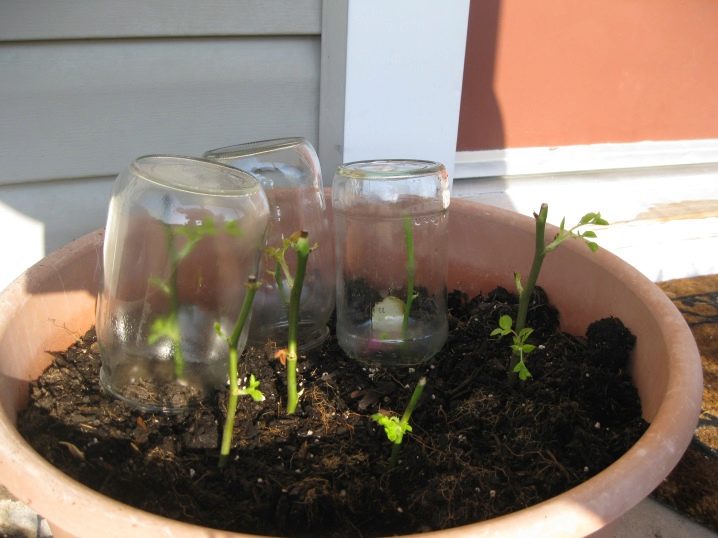
Selection and preparation of cuttings
Yes, you can extend the life of a bouquet, but if purchased roses are Dutch, nothing will come of it. Flowers that come from the Netherlands are processed with a special composition even before transportation. This is done so that they calmly survive the road and retain their blooming appearance during potential sales. But you can take a chance with domestic flowers. If they are cut on the day of purchase, the chances of successful rooting are even greater.
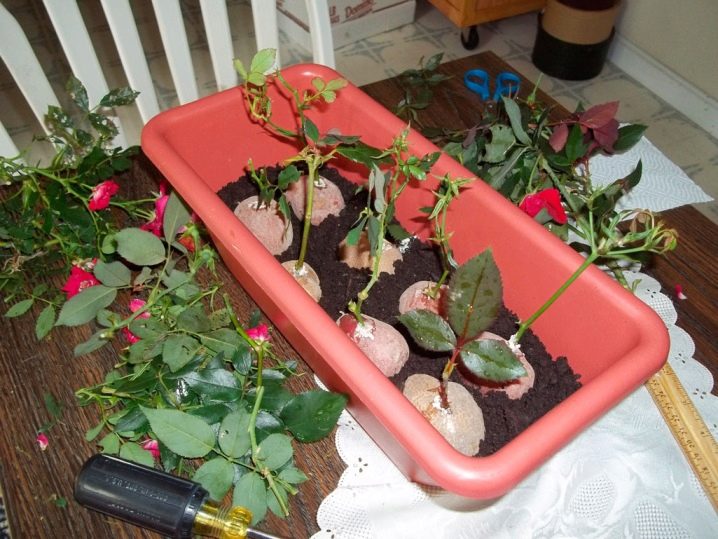
Let's see what other requirements must be met for successful breeding.
- Freshness. If the plant is elastic, smooth, not fully opened and in the so-called shirt (that is, in greenish petals), it is fresh. There should be no spots and mucus on the cut, the stem should be dense and even. Fresh foliage will definitely be bright green, glossy, it should not have specks. If the color is changed, and the leaf itself is sluggish, it means that the plant was cut for a long time. And if the flower is also wrapped with tape at the base, it is definitely unsuitable for rooting. Painted, sequined roses are also unusable.
- Tint. Classics (white and red roses) will take root better. According to the observations of flower growers, it is these shades that are the most tenacious, it is beneficial to propagate them. Teas, yellows and purples behave in a much more unpredictable manner.
- Seasonality. The rose must be summer. From the very end of May to August, the flowers are more suitable for reproduction. But early spring, autumn and winter are extremely unfortunate seasons for such experiments. It is cold, it is not particularly sunny, it is simply impossible to land it in open ground. And this is taking into account the fact that root formation lasts a month. That is, you also need to be in time before the cold weather in any case.
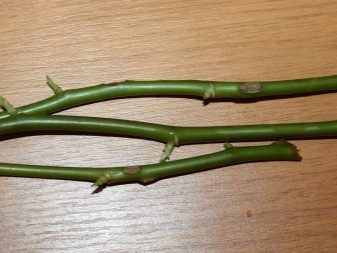
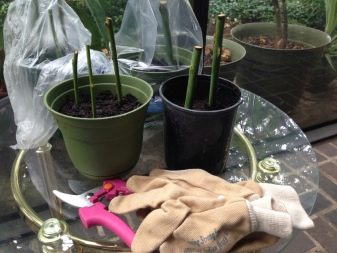
And you also need to look at the stem: very thin and flexible will definitely not work. Very thick, lignified, also not suitable for breeding. A stalk with a pencil thick is the best option.

Storage methods
For example, roses were received as a gift in the fall or winter, and you want to keep the cuttings until spring in order to later grow a flower in the ground. Then you need to determine which storage method for the flower is chosen. This can be, for example, a paraffin bath: the stalk must "bathe" in molten paraffin.
First, the paraffin is placed in a water bath, and when it melts, the upper cutting part is lowered into it, very quickly, and then just as quickly it is sent into cold water. The operation is repeated twice or thrice. Then these shoots are placed in a box of sand, sprinkled with it and sent to the cellar: there they will calmly live until spring. If there is no cellar, you can store it in the refrigerator. The lower part is wrapped in wet moss, the cutting is placed in a bag and sent to the lower shelf of the refrigerator.
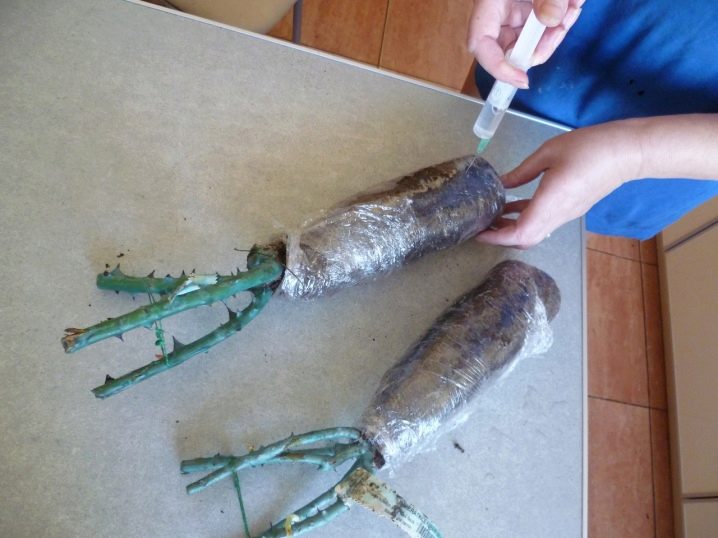
As the moss dries, it must be moistened.
Cuttings can also be stored outdoors if the climate is mild. At the bottom of a specially dug trench, straw is spread, where cuttings are placed. They are also covered with straw from above. Then comes the soil layer. Cuttings should not be placed close to each other. This is how they, too, will calmly survive the winter.

How to root?
Before cutting a flower, it must be prepared for the procedure. That is, it is correct to select the cuttings themselves. If it is decided to use a fresh rose, the cuttings are used immediately, if the yesterday's cut, the dried cuttings are first pruned and the cuttings are placed in cold water for 2 hours. But both the one and the other option have equal chances of success in cuttings. Much more important is how exactly the stem looks: is it healthy, is it strong, is there any signs of decay in it. Young and green shoots do not have sufficient strength for growth, and those that are already stiff do not always germinate well, and, alas, they are especially prone to decay.
Cutting of donated or purchased roses is carried out only with a sharp knife or pruner, and must be sterile. A dull blade easily injures the stem.
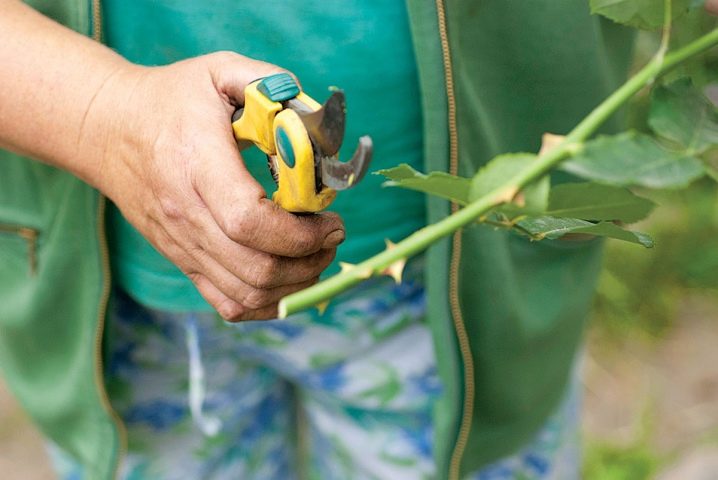
For normal preparation of the instrument, it is enough to spill it with boiling water and rinse it with soapy water.
The standard rooting algorithm at home looks like this.
- Only strong flowers are selected from the bouquet. All buds are cut on them.
- The stem must be cut into cuttings, each about 20 cm long. An oblique cut is made on the bottom of the stem, increasing the absorption surface. The cut usually starts a couple of centimeters from the lower kidney. A straight cut is made from above, that is, 2 cm from the upper kidney. Each sample must have at least 2 buds (growth points).
- All the lower leaves are removed, and the upper ones are cut off by a third. This will reduce the loss of moisture. But all the sheets do not need to be removed.
- A container with clean, previously settled water is being prepared. You can also send a couple of drops of a growth stimulant there. The cuttings are lowered into this water by a third (always with an oblique cut down) and stay there for 6 hours.
- Rooting takes place in one of the popular ways. There are several of them, you can try a couple of them at once to increase the likelihood of successful rooting. Therefore, cuttings are usually harvested with a margin.

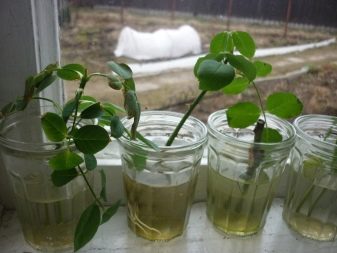
A little more about the need for a growth stimulant: these drugs or agents activate root growth, the bush with their help takes root faster, and its immunity increases.
They are made with their own hands at home: they mix water and honey (a teaspoon of honey per 1 liter of water) or mix 1 part of aloe juice with 10 parts of water.
Or you can buy Kornevin or Zircon, Epin-Extra, etc.
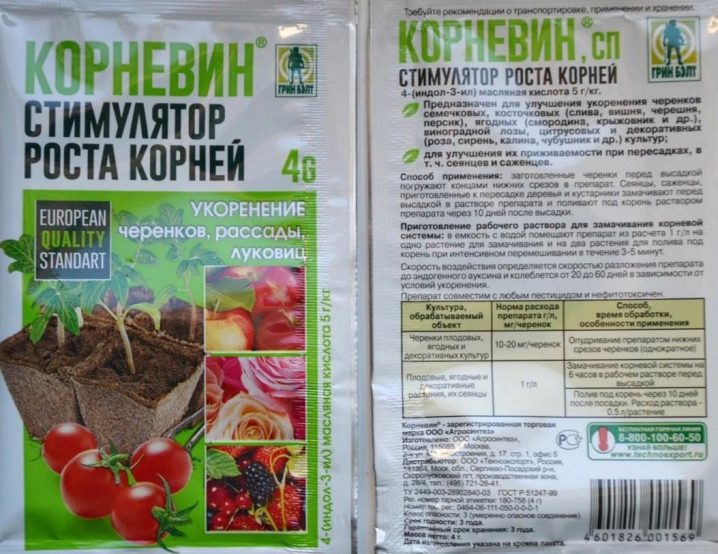
In water
This method of germinating a rose is usually the most requested. It would seem that it could be easier, because you just need to put the flower in the water. But not all water will do either. Rainwater works well, filtered from a tap is also good. But you should not use melt water. Water is poured into a clean container, cuttings are sent into it. And then the container with water is placed in a place where the sun's rays will not penetrate. Water must be changed every day for fresh water, to see if stem rot has formed. Sometimes complex compounds are added to the water to stimulate root formation. But just do not add them so that the solution becomes concentrated: it simply burns the plant.
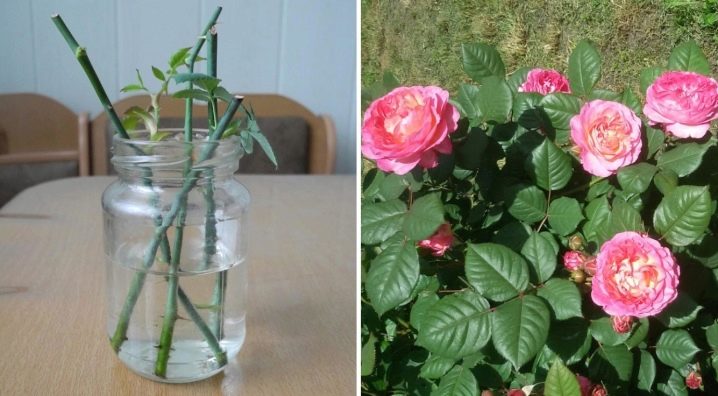
In potatoes
This is an unexpected solution, but it works great. You need to stick the cuttings from the branches into the potatoes. The fact is that tubers are considered an ideally balanced medium of starchy components and liquid, that is, for sprouting roots, this is the best option. Tubers should be chosen good: medium, strong, without rotten fragments and signs of wilting. The potatoes are thoroughly washed, put in a pink solution of potassium permanganate.
Then they dry it, make a depression in it, commensurate with the diameter of the branch. The deepening should not be through.
A cutting is placed in the hole made, and the tuber itself is buried in a pot with earth. The soil is watered, covered with a plastic bottle to create a mini-greenhouse. As soon as the first shoots are found, the seedling must be ventilated at least once a day.After the formation of roots, you can break the tuber and transplant the culture into the ground, or you can leave the potato as a natural fertilizer.


Burrito method
A burrito is a Mexican tortilla. It has either meat or vegetable filling, or even all of them. But in the case of the rooting of the rose, the filling will be the stalk, and the wet newspaper will become the cake. It's simple: thick cuttings are treated with a growth stimulant, wrapped in a damp newspaper. Water should not leak from the paper (this is important).
Then such a "cake" is sent to a plastic bag, the regular temperature of the place of its storage should be about +20 degrees.
The paper is opened about once a week to check for rot. Soon, growths will appear on the cut areas: this indicates that the flower is ready to live in the ground.
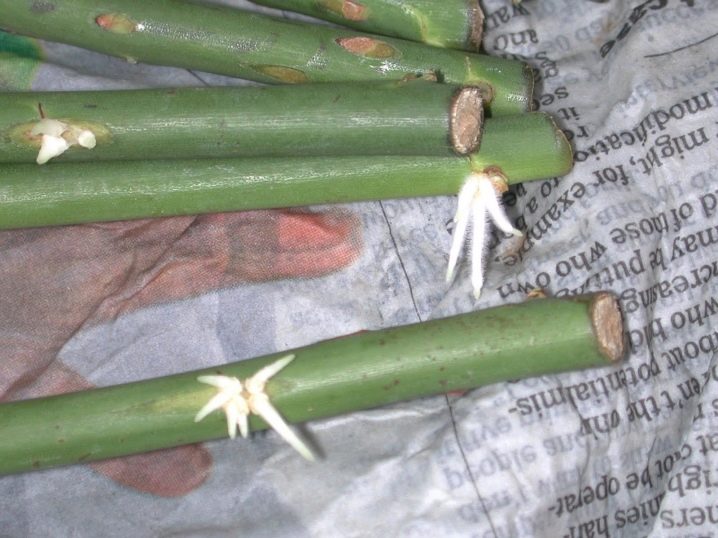
In the package
This is also an interesting and quite feasible technology. The package itself must be filled with soil that is optimal for roses, the soil should take up a third of the total volume. The cut of the cutting is moistened with any growth stimulant. And the remaining volume of the bag is simply filled with air and the container is tied at the top.
It is necessary to grow roses in a suspended state, always on the sunny side (near the east or south window). After about a couple of weeks, the first shoots will appear. And after 2 or 3 months, the rose will be ready for planting in the ground.
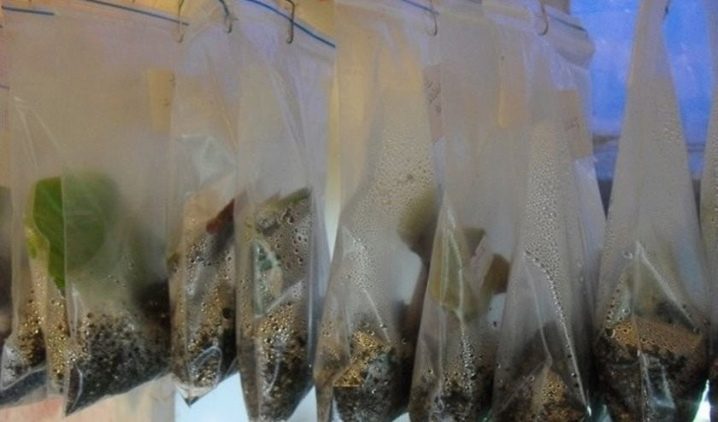
In the ground
It seems that this method is the most logical: we plant the cutting in the ground, and everything will go naturally. But only this method, although effective, is technologically the most difficult. For cuttings, you need to choose a suitable container. If each stem is sent to an individual container, these will be half-liter pots.
But some of the cuttings will inevitably die, so it's better not to rush to buy pots. It is much more rational to plant several plants in one container.
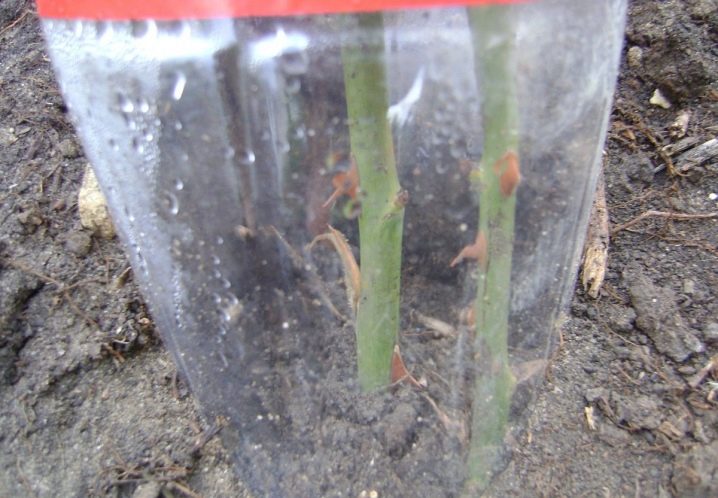
Planting cuttings in a pot step by step is as follows.
- The container, like the instrument, must be treated with a pink solution of potassium permanganate. This is a standard decontamination procedure because fungal and bacterial infections can overwhelm the effort.
- A drainage layer is laid out at the bottom of the container: it can be crushed stone, gravel or broken cuttings. Its height usually reaches 5 cm or a little less. Instead, there may be pieces of styrofoam. Drainage should be spilled with boiling water or rinsed with manganese solution.
- A suitable soil is placed in the pot, which needs to be compacted a little (but you should not tamp it). Soil mixture for roses is sold in any specialty store, but you can make the substrate yourself: take 2 parts of garden soil and 1 part of sand. It makes sense to heat the soil in the oven for the purpose of disinfection.
- A small depression is made in the ground, a stalk is planted there, sprinkled with earth. If there are several seedlings, you can evenly distribute them over the soil surface; an interval of 6 cm should be maintained between the neighboring flowers.
- Now the soil must be watered with rain or rather cool, settled water.
- Creating a greenhouse effect is a must. The entire pot is covered with foil; instead, you can use a cut plastic bottle. A disposable cup will also work.
- If necessary, the seedling is watered. And in order not to erode the ground, it is better to organize watering with a sprayer.
- Once a day, the flower is ventilated: first 3 minutes, then longer. When the first green leaves appear, the mini-greenhouse is removed as unnecessary.
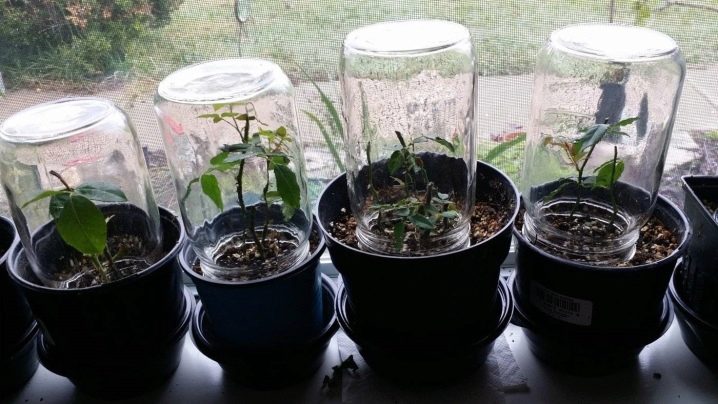
How to plant correctly?
Of course, you must first of all think about where the flower will grow. And he can grow both at home and on the street. With the second option, everything is more difficult, because the harsh winter will not spare the flower in the country. But if it is nevertheless decided to plant it in open ground, then they usually do it in late spring, choosing a warm place with good illumination for the rose.
And there it will bloom until the first frost.After that, the bushes must be dug up, cut off and sent to the pot for the winter.
True, there are varieties that winter well in the ground, only they are reliably covered with straw, fallen leaves, or a rather thick layer of sawdust. If the rose is not planned to be placed in open ground, then its transplant is also going on in the spring. But still, the climate at home is better, so you can plant a rose not only in May, but also in the first spring month. And here the technology is repeated with cuttings.

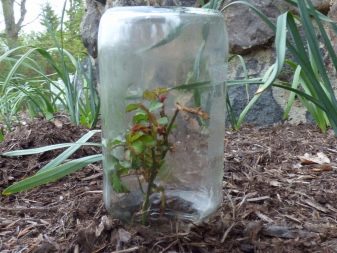
Follow-up care
Let's see what is important to know about successfully caring for roses grown in the described way:
- the rose needs to organize a bright place, but without direct ultraviolet radiation (in the shade and partial shade, the flower quickly becomes shallow and dies);
- watering is supposed to be regular and moderate, because excess moisture is often associated with root rot and the subsequent death of the bush;
- dry air in space is also unacceptable, because it leads to wilting of the rose and the dropping of barely set buds (in this regard, the bush must be sprayed regularly);
- in the summer, the rose can stay on the loggia or veranda;
- in winter, overheating becomes dangerous for her, so it is often necessary to ventilate the room;
- in the fall, the home rose will have to be cut: let no more than 5 buds remain on each shoot, and the cut branches will go well for planting;
- watering in the fall is carried out no more than once every 5 days;
- as soon as active growth begins, the bush should be fed, this is done every 2 weeks (you can use a solution of bird droppings).
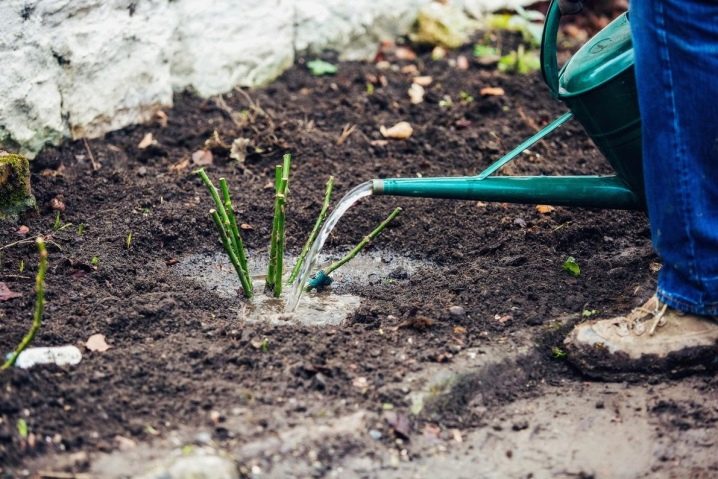
If all of the above seems complicated, then it is better to choose some more reliable method and abandon the idea of growing roses from a bouquet. It doesn't matter if it is a bush flower or another species. Then it is easier to go to the nursery, buy a seedling there and start growing it in the ground. But here, too, there are some nuances: planting material can be expensive, its quality is also not always clear, sometimes it does not develop well enough. And in this sense, even grafting becomes a more profitable way, it helps to plant roses without much spending.
It is time to transplant a rose, diluted by cuttings from a bouquet, if the plant is developing normally. In the third or fourth week, it will take root.

The onset of root formation can be checked by slightly pulling the stem upwards. If it is decided that the time for transplanting has already been lost, you can give the cuttings another year. You just need to make sure that it is stored in a suitable place, without drafts. And around July it can be planted in the ground.
The rose will love to grow in fertile soil, which it would not hurt to fertilize before planting the flower. The hole should be free, 5 cm deep, so that the roots are comfortable there. And then everything follows the standard scheme: watering, shelter, fertilizers. In the second or third year, it is worth waiting for the rose to bloom. It is normal if she does not bloom in the first year: at this time, her strength is spent on the development of the root system.
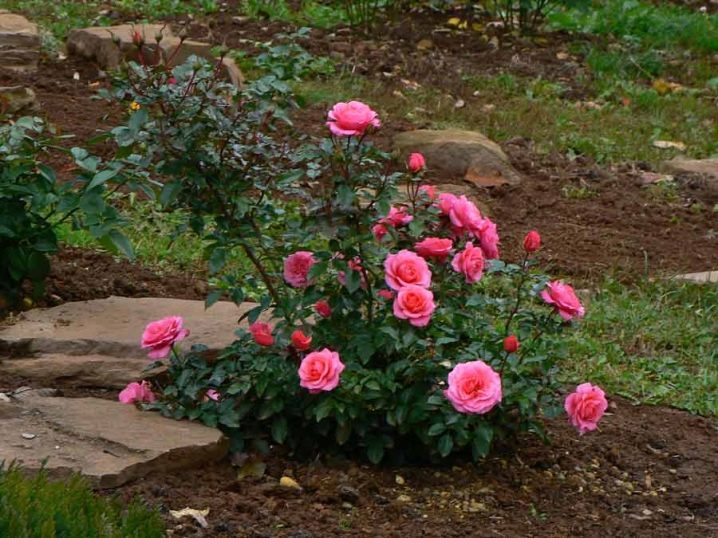

































































































The comment was sent successfully.